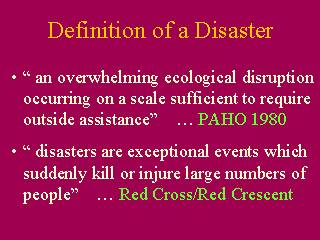|
|
|
|
front
|1
|2
|3
|4
|5
|6
|7
|8
|9
|10
|11
|12
|13
|14
|15
|16
|17
|18
|19
|20
|21
|22
|23
|24
|25
|26
|27
|28
|29
|30
|31
|32
|33
|34
|35
|36
|37
|38
|
 |
In general, most disaster events are defined by the need for external assistance. Perhaps, one reason for this observation is that the disaster relief agencies are often the only organizations with comprehensive and systematic data. There should be some
caution applied to data defined in this circumstance. Notably, the decision on which situations require external assistance may differ by country or region. In some situations, it may be a political decision as well.
The Center for Research on the Epidemiology of Disasters (CRED) in Brussels, Belgium, uses the following definition. “A disaster is a situation or event which overwhelms local capa
city, necessitating a request to a national or international level for external assistance.” CRED maintains a database of disaster events from 1900 to present. Much of their data is derived from relief groups, including the
Red Cross/Red Crescent Agency.
Other information: How a Disaster is Declared, USAID |